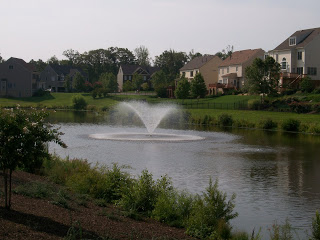Seasonal Turf Practices and Your Pond
February 1st, 2012
By Industry Expert Dave Ellison, Aquatic Biologist
 Landscaping practices often cause significant impacts on the water quality and plant and algae growth within a pond. Buffer management, debris falling into the pond, and poorly managed fertilizer applications are some of the practices that attribute to problems in ponds. Excessive application of fertilizer will allow for more nutrients to enter the pond, creating a source of energy for algae to grow.
Landscaping practices often cause significant impacts on the water quality and plant and algae growth within a pond. Buffer management, debris falling into the pond, and poorly managed fertilizer applications are some of the practices that attribute to problems in ponds. Excessive application of fertilizer will allow for more nutrients to enter the pond, creating a source of energy for algae to grow.
When applying fertilizer you should make sure it is done responsibly to ensure that the product is utilized by the grass and not washed away. One of the first things that you should do is read the label on the product you are applying. Labels on fertilizer bags show three numbers. The first number lists the amount of nitrogen in the bag, the second is the amount of phosphorous, and the third lists the amount of potassium. A soil test could be performed to determine what fertilizer would work best for your lawn. Phosphorous free fertilizers often work well on most lawns. Phosphorous is often the growth limiting nutrient for algae and when lower amounts of phosphorous are present, pond algae typically has a difficult time growing.
Application of fertilizer does not have to be done to the edge of the water.Excess fertilizer will likely accumulate at the water’s edge and this can be avoided by using a rotary spreader to spread adequate amounts of fertilizer to the grasses near the edge of the pond.Application can often be done just once a year for many types of grasses with fall being the best time for application.This season is often best because the lawn will frequently need nutrients to recover from the stress of the summer months and the turf will be able to become stronger going in to the winter and the following year.
Many people like to apply fertilizer during the spring growing season, but this is not needed.Spring is often better to concentrate on the prevention of crabgrass and other weeds and your yard will thank you in the coming months.The fertilizer can sometimes get washed away and run off with spring rainfalls before grasses have established themselves for the growing season.
One of the most important things to remember is to prevent spills and spreading the product in to drains or ditches that flow into ponds. Runoff is a major source of nutrient input for ponds and the added input from fertilizer will further degrade the water quality in your pond.Responsible lawn practices are not only beneficial for your lawn, but also will prevent long term pond problems.
Contact the experts at 888-480-5253 for all of your lake, pond and fisheries management needs.
Since 1998, SOLitude Lake Management has been committed to providing full service lake and pond management services that improve water quality, preserve natural resources, and reduce our environmental footprint. Services are available throughout the Eastern United States. Fisheries management consulting and aquatic products are available nationwide. Learn more about SOLitude Lake Management and purchase products at www.solitudelakemanagement.com.










